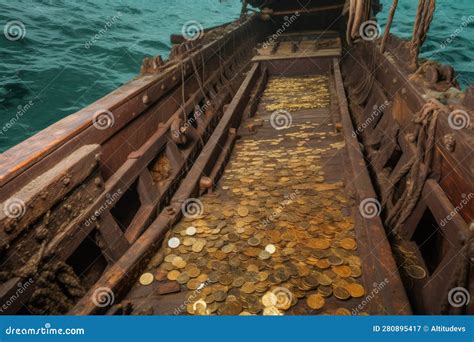
A shipwreck potentially laden with a staggering £16 billion ($20 billion) worth of treasure has reportedly been discovered, igniting speculation of a modern-day Caribbean gold rush. While the identity of the finder remains undisclosed, the implications of such a find could be transformative for the region and the field of marine archaeology.
The discovery, if verified, would dwarf previous treasure finds and raise complex legal and ethical questions regarding ownership, salvage rights, and the preservation of historical artifacts. The potential economic impact on the Caribbean, a region heavily reliant on tourism, is considerable, though experts caution against premature exuberance, emphasizing the significant challenges and costs associated with recovering and securing such a vast hoard.
The identity of the shipwreck itself remains a closely guarded secret. While rumors circulate, no official confirmation has been made regarding its origin, the specific location of the wreck, or the types of treasure believed to be contained within. The lack of transparency surrounding the discovery has fueled speculation and debate within the maritime and historical communities.
Legal and Ethical Considerations
The legal framework governing shipwrecks and underwater cultural heritage is complex and varies depending on the location of the wreck and the nationality of the vessel. International treaties, such as the UNESCO Convention on the Protection of the Underwater Cultural Heritage, aim to safeguard shipwrecks and their contents for historical and scientific purposes. However, the United States and several other nations have not ratified this convention.
The principle of finders keepers generally does not apply to shipwrecks, particularly those of historical significance. Most nations assert ownership over shipwrecks within their territorial waters, and even those located in international waters may be subject to claims by the vessel’s flag state or the descendants of its owners. Salvage rights, which allow individuals or companies to recover items from a shipwreck in exchange for a portion of the recovered treasure, are typically granted by a court of law.
Ethical considerations also play a crucial role in the management of shipwrecks. Archaeologists and historians argue that shipwrecks are valuable historical resources that should be studied and preserved for the benefit of future generations. They often advocate for non-disturbance of wrecksites and the use of non-destructive methods of investigation. Commercial salvage operations, on the other hand, prioritize the recovery of valuable items, which can sometimes lead to the destruction of the wreck and the loss of important historical information.
Potential Contents of the Shipwreck
Given the reported value of the treasure, the shipwreck likely dates back to the colonial era, a period characterized by extensive maritime trade and numerous shipwrecks in the Caribbean. Spanish galleons, which transported vast quantities of gold and silver from the Americas to Europe, were frequent targets for pirates and privateers, and many were lost in storms or battles.
The treasure could include gold and silver coins, precious jewels, artifacts, and other valuable items. The “Yahoo Finance” article mentions the potential for “vast quantities of gold, silver and emeralds.” Such a discovery would provide invaluable insights into the economy, trade, and culture of the colonial era.
Challenges of Recovery
Recovering treasure from a shipwreck is a complex and challenging undertaking. The wreck may be located in deep water, requiring specialized equipment and expertise. The marine environment can be harsh, with strong currents, poor visibility, and the risk of storms. The wreck itself may be fragile and unstable, requiring careful excavation to avoid further damage.
The cost of recovery can be substantial, involving significant investment in technology, personnel, and logistics. The salvage team must also obtain the necessary permits and approvals from the relevant authorities, which can be a lengthy and bureaucratic process.
Once the treasure is recovered, it must be carefully documented, conserved, and analyzed. This process can take years, and the cost can be considerable. The treasure must also be secured to prevent theft or damage.
Economic Impact on the Caribbean
The discovery of a £16 billion treasure could have a significant economic impact on the Caribbean, a region that has faced economic challenges due to its dependence on tourism. If the treasure is recovered and properly managed, it could generate substantial revenue for the local economy through tourism, job creation, and investment.
However, experts caution against excessive optimism. The recovery of the treasure could also have negative consequences, such as an increase in crime, corruption, and environmental damage. It is essential that the recovery process is carefully managed to ensure that the benefits are shared equitably and that the environment is protected.
The government of the country where the shipwreck is located will likely play a key role in managing the recovery process and ensuring that the treasure is used for the benefit of its citizens. This could involve establishing a trust fund to manage the revenue generated by the treasure, investing in education and infrastructure, and promoting sustainable tourism.
Historical Context of Caribbean Shipwrecks
The Caribbean Sea served as a vital artery for European colonial powers, particularly Spain, during the 16th to 18th centuries. Spanish galleons, heavily laden with treasures plundered from the Americas, traversed these waters en route to Europe. This made the Caribbean a hotbed for piracy and naval warfare, resulting in numerous shipwrecks that now lie scattered across the seabed.
Famous shipwrecks like the Nuestra Señora de Atocha, a Spanish galleon that sank off the Florida Keys in 1622, have yielded immense treasures. Discovered in 1985 by Mel Fisher, the Atocha contained gold, silver, emeralds, and artifacts valued at hundreds of millions of dollars. Such discoveries underscore the potential riches that may still lie hidden beneath the waves of the Caribbean.
The allure of sunken treasure has captivated explorers, historians, and treasure hunters for centuries. The romance of piracy, the allure of lost riches, and the opportunity to uncover historical artifacts have fueled countless expeditions to the Caribbean in search of shipwrecks.
The Role of Technology in Shipwreck Discovery
Modern technology has revolutionized the field of marine archaeology and shipwreck discovery. Side-scan sonar, which uses sound waves to create detailed images of the seabed, can detect shipwrecks and other underwater features. Remotely operated vehicles (ROVs), equipped with cameras and sensors, can explore shipwrecks in deep water. Global Positioning System (GPS) technology allows for precise location of wrecksites.
These technologies have made it possible to discover and investigate shipwrecks that were previously inaccessible. They have also made the process of recovering treasure from shipwrecks more efficient and less risky.
Future Implications
The discovery of this potential £16 billion treasure could have far-reaching implications for the field of marine archaeology, the Caribbean economy, and the legal framework governing shipwrecks. It could spur renewed interest in shipwreck hunting, leading to further discoveries. It could also lead to increased investment in marine archaeology and the development of new technologies for exploring and preserving shipwrecks.
The legal and ethical issues surrounding shipwreck ownership and salvage rights will likely become more complex as technology makes it easier to discover and recover treasure from shipwrecks. It is essential that these issues are addressed in a fair and equitable manner that protects the interests of all stakeholders.
Community Reactions and Expert Opinions
The news has elicited a mixed response from the archaeological and historical communities. While the potential for historical discovery is acknowledged, there’s also concern regarding the handling of the site. “The manner in which such finds are managed is crucial,” states Dr. Emily Carter, a maritime archaeologist at the University of the West Indies, adding, “It’s not just about the monetary value; it’s about the story these wrecks tell and ensuring they are preserved for future generations.”
Local Caribbean communities also express cautious optimism. Many hope the discovery will bring economic benefits to the region, but also voice concerns about potential exploitation and environmental damage. “We’ve seen promises before,” says Maria Sanchez, a resident of a small coastal town, “We hope this time it truly benefits the people and protects our natural heritage.”
Comparison to Previous Discoveries
The reported value of this potential treasure dwarfs previous significant shipwreck discoveries. The Nuestra Señora de Atocha‘s treasure, while substantial, pales in comparison to the alleged £16 billion. The Whydah Gally, a pirate ship discovered off the coast of Cape Cod, yielded a significant collection of artifacts, but its monetary value was far less than the current claim.
This potential find raises the stakes significantly, highlighting the potential for undiscovered wealth lurking beneath the ocean’s surface. It also underscores the ongoing debate regarding the ethics of treasure hunting versus archaeological preservation.
The Search for Transparency
The secrecy surrounding the finder and the exact location of the shipwreck raises concerns about transparency. Without independent verification and archaeological oversight, the historical and scientific value of the find could be compromised. Open communication and collaboration between the finders, government authorities, and archaeological experts are essential to ensure responsible management of this significant discovery.
Political and Geopolitical Ramifications
The discovery could also have political and geopolitical ramifications, particularly if the shipwreck is located in disputed waters or if multiple countries lay claim to the treasure. International law and treaties will play a crucial role in resolving any disputes and ensuring that the treasure is managed in a fair and equitable manner. The country in whose territorial waters the wreck lies will likely have the primary claim, but other nations might assert historical or ownership rights.
Environmental Considerations
Shipwreck recovery can have significant environmental impacts. The excavation process can disturb marine habitats, damage coral reefs, and release pollutants into the water. It is essential that the recovery operation is conducted in an environmentally responsible manner, with measures in place to minimize damage to the marine environment. This includes conducting environmental impact assessments, using non-destructive excavation techniques, and implementing pollution control measures.
The Preservation of Cultural Heritage
Shipwrecks are not just sources of treasure; they are also important cultural heritage sites that provide insights into the past. The preservation of shipwrecks is essential for understanding human history, trade, and culture. This includes protecting shipwrecks from looting and damage, documenting their contents, and making them accessible to the public.
The Role of Museums and Research Institutions
Museums and research institutions play a crucial role in the study and preservation of shipwrecks. They provide expertise in archaeology, conservation, and history. They also provide a public forum for learning about shipwrecks and their significance. Museums can display artifacts recovered from shipwrecks, conduct research on their history and significance, and educate the public about the importance of preserving cultural heritage.
Impact on Tourism
If managed correctly, the discovery could significantly boost tourism in the Caribbean. A museum dedicated to the shipwreck and its contents could attract visitors from around the world. The shipwreck itself could become a diving site, offering tourists the opportunity to explore a piece of history firsthand. However, it is essential to manage tourism sustainably to minimize its environmental and social impacts.
The Human Element
Beyond the gold and jewels, shipwrecks are also a reminder of the human lives lost at sea. Each shipwreck represents a tragedy, and it is important to remember the human cost when considering the recovery of treasure. The discovery of human remains on a shipwreck site requires respectful treatment and the involvement of forensic experts to identify the individuals and learn about their lives.
The Future of Marine Archaeology
The discovery of this potential £16 billion treasure underscores the importance of marine archaeology and the potential for further discoveries in the future. As technology advances and exploration efforts expand, it is likely that more shipwrecks will be discovered, shedding new light on human history and culture. It is essential to support marine archaeology and ensure that shipwrecks are studied and preserved for the benefit of future generations.
The Ongoing Investigation
As of the latest reports, the details surrounding the find remain shrouded in secrecy. Further investigation and verification are needed to confirm the authenticity of the treasure and the identity of the shipwreck. The outcome of this investigation will have significant implications for the future of marine archaeology, the Caribbean economy, and the legal framework governing shipwrecks.
Conclusion
The reported discovery of a potential £16 billion treasure in a Caribbean shipwreck has captured the world’s attention. While the details remain uncertain, the find highlights the potential for undiscovered wealth and historical knowledge beneath the ocean’s surface. The ethical, legal, and economic implications of such a discovery are significant and require careful consideration. Responsible management, transparency, and collaboration between all stakeholders are essential to ensure that this potential treasure is used for the benefit of all and that the historical and cultural value of the shipwreck is preserved for future generations. The potential impact on the Caribbean region is immense, but sustainable and equitable practices must be at the forefront of any recovery and management plan. The allure of gold may spark a modern-day “gold rush,” but the true treasure lies in the preservation and understanding of our shared maritime history.
Frequently Asked Questions (FAQs)
-
How much is the reported treasure worth?
The reported treasure is estimated to be worth £16 billion, which is approximately $20 billion USD.
-
Where was the shipwreck discovered?
The article indicates the shipwreck was found in the Caribbean, but the specific location has not been disclosed.
-
Who discovered the shipwreck?
The identity of the person or group that discovered the shipwreck has not been revealed. The article only mentions the finder is undisclosed.
-
What types of treasure are believed to be on board?
The treasure is believed to include vast quantities of gold, silver, and emeralds, according to the original Yahoo Finance article.
-
What are the legal implications of finding such a valuable shipwreck?
The legal implications are complex and depend on the location of the wreck, the nationality of the vessel, and international treaties. Ownership claims could be made by the country in whose territorial waters the wreck lies, the vessel’s flag state, or the descendants of its owners. Salvage rights may also be granted by a court of law.









